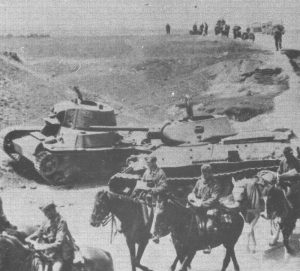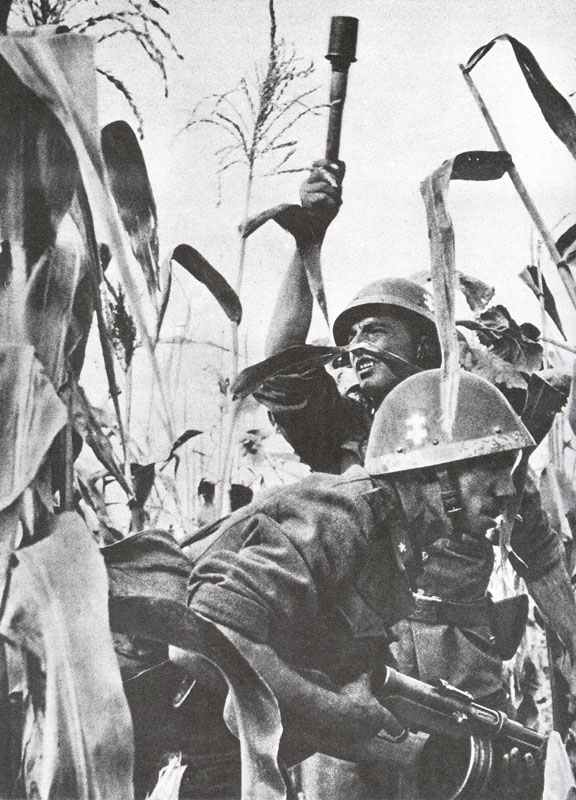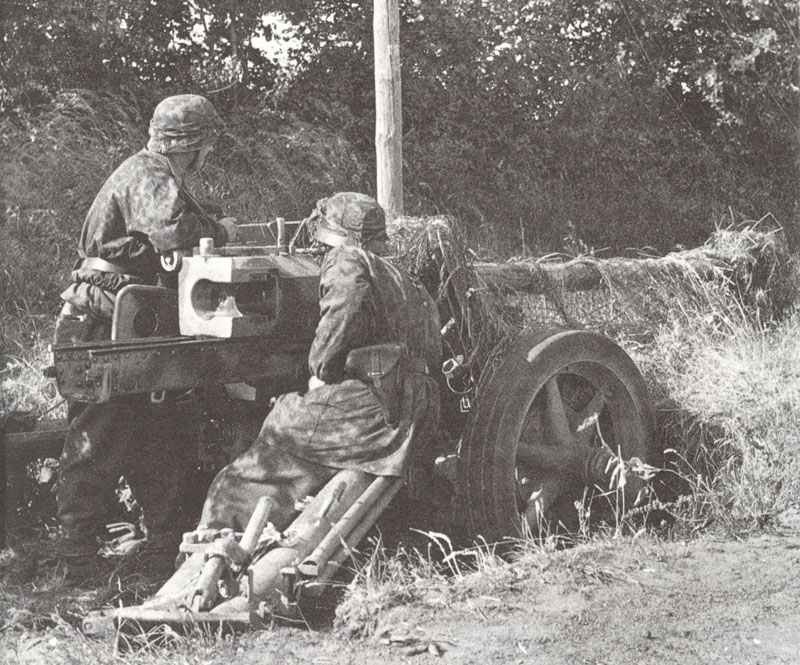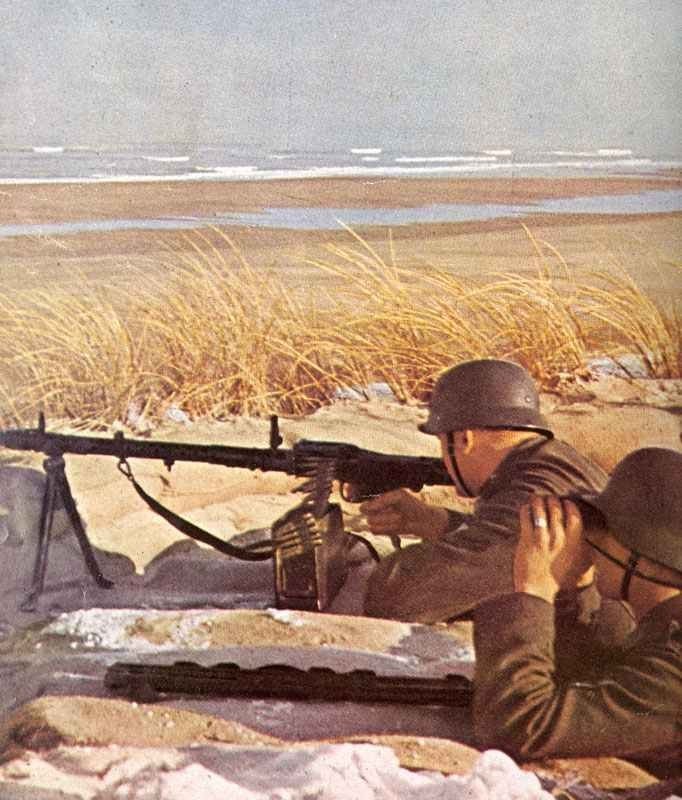Strength and Organization of the Red Army at Operation Barbarossa in June 1941.
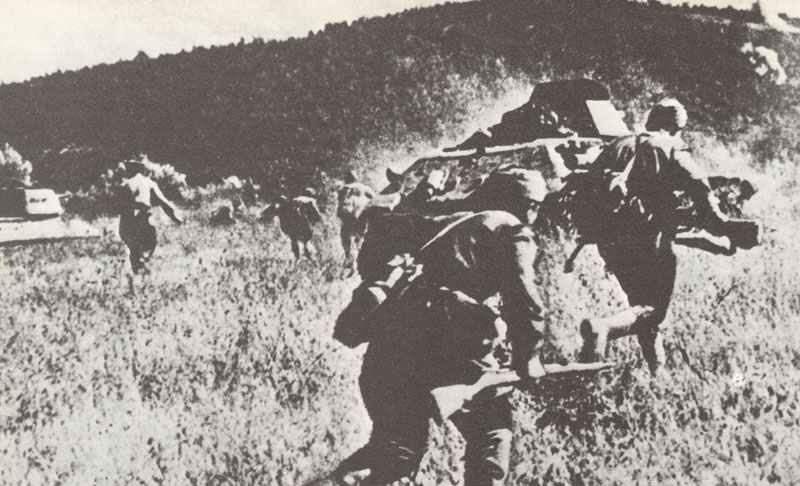
The Red Army in 1941
Table of Contents
On paper, the Red Army of the summer of 1941 was a formidable force; in practice, there were still grave deficiencies which would be ruthlessly exposed by the Wehrmacht. The fighting on the Eastern Front dwarfed that in most other theaters, the numbers of men and vehicles involved were enormous, as were the casualties.
During the first German assaults, the Red Army almost collapsed. Units fell back, leaving behind them huge quantities of valuable supplies, ammunition and irreplaceable heavy equipment. Formations and units lost their coherence, and headquarters, often staffed by completely inexperienced staff officers, struggled with poor communications.
From June until the end of the year, the Red Army withdrew eastwards, suffering grievous losses but also inflicting heavy losses on the enemy. In the autumn, the front line ran from Leningrad in the north to Odessa in the south, but the Red Army had lost nearly one-third of its entire prewar strength. Despite these colossal defeats, the Germans had failed to annihilate the Red Army and had failed to take either Leningrad or Moscow.
Moscow now became the focal point of German efforts, while Stalin, as Supreme Commander, decided to remain in Moscow and defend the capital to the bitter end.
Orders of Battle of the Red Army in June 1941
Although it is hard to arrive at a completely accurate figure, there were about 170 million people in the Soviet Union in 1941, of whom all eligible adult males, totaling 25 million, were liable for military service. The length of service was two years, after which the recruit would go into the reserves, ready to be called to the colors when necessary.
The quality of peace-time training in the Red Army left much to be desired: instruction was by rote learning, so that recruits were taught to value obedience over initiative. The sluggish Soviet response to the German invasion reflected an inadequate level of technical competence.
The regular army consisted of some nine million men, of whom about a half were based in the European Soviet Union.
On the western front the Russians deployed 170 divisions (of about 230 divisions) in five major groups: Leningrad Military District (three armies); Baltic Special Military District (two armies); West Special Military District (three armies); Kiev Special ¥ilitary District (four armies) and the Odessa Military District (two armies).
Orders of Battle of the Red Army on June 22, 1941:
Northern Front (Leningrad):
| Army | Corps | Divisions |
|---|---|---|
| total 17-19 Rifle, 2 Tank, 1 Mech. divisions | ||
| 14th Army (Murmansk) | 4 Rifle divs | |
| 7th Army (Karelia) | 3 Rifle divs | |
| 23rd Army (Leningrad) | X Mech. Corps (north of Leningrad, Gen Lavionovich) | 1 TD, 24 TD, 198 MD |
| XIX, L, LXX Rifle Corps | (at least 1 Rifle div on the Karelian Isthmus) |
North-West Front (Baltic, Gen Kusnezow):
| Army | Corps | Divisions |
|---|---|---|
| total 28-29 Rifle, 6 Tank, 3 Mech. divisions, 4 Cavalry Brigades | ||
| 8th Army (Gen Sobennikov) | XII Mech. Corps (Shauliya, Gen Shestpalov) | 23 TD, 28 TD, 202 MD (total 690 tanks, none T-34/KV) |
| X, XI Rifle Corps | 9 Rifle divs | |
| 11th Army (Kaunas, Gen Morossov) | III Mech. Corps (Vilno, Gen Kurkin) | 2 TD, 5 TD, 84 MD (total 460 tanks, incl 105 T-34/KVs) |
| I Mech Corps (Reserve in Pskov, Gen Chernyavsky) | 1 TD, 3 TD, 163 MD (total 163 tanks) | |
| XXII, XXIV, LXI Rifle Corps | 11 Rifle divs | |
| 27th Army (Reserve) | XXII, XXIV, LXI Rifle Corps | ? |
Western Front (Minsk, Gen Pavlov):
| Army | Corps | Divisions |
|---|---|---|
| total 30-31 Rifle, 10 Tank, 5 Mech., 2 Cavalry divisions, 3 Air Landing brigades | ||
| 3rd Army (Gen Kusmezov) | XI Mech. Corps (Grodno, Gen Mostovenko) | 29 TD, 33 TD, 204 MD (total 204 tanks, incl 27 T-34/KVs) |
| IV Rifle Corps | 12 Rifle divs | |
| 10th Army (Bialystok, Gen Golubev) | VI Mech Corps (Bialystok, Gen Khatskilevich) | 4 TD, 7 TD, 29 MD (total 1,000 tanks) |
| XIII Mech. Corps (Belsk, Gen Akhlyustan) | 27 TD, 31 TD, 4 MD (total 300 tanks) | |
| I, V Rifle Corps | 8 Rifle divs | |
| 4th Army (Brest-Litovsk, Gen Korobkow) | XIV Mech. Corps (Brest-Litowvsk, Gen Oborin) | 22 TD, 30 TD, 205 MD (total 508 tanks) |
| XXVIII Rifle Corps | 6 Rifle divs | |
| 13rd Army (Reserve in Minsk, Gen Filatow) | XX Mech. Corps (Minsk, Gen Vedeneyev) | 26 TD, 38 TD, 210 MD (total 300 tanks) |
| II, XXI, XLIV, LXV Rifle Corps | 4 Rifle divs | |
| Reserves: | IV Air-Landing, XVVII, XL Rifle Corps | amongst others 3 Air-Landing brigades |
South-West Front (Kiev, Gen Kirponos):
| Army | Corps | Divisions |
|---|---|---|
| total 45 Rifle and Mountain (incl 2 as reserve), 16 Tank, 8 Mech., 10 Cavalry divisions | ||
| 5th Army (Rovno, Gen Potapov) | XXII Mech. Corps (Rovno-Dubno, Gen Kondrusev) | 19 TD, 41 TD, 215 MD (amongst others 31 T-34/KVs) |
| XVII Mech. Corps (Baranovichi, Gen Petrov) | 25 TD, 54 TD, 108 MD (total 300 tanks) | |
| XV, XXVII Rifle Corps | 10 Rifle divs | |
| 6th Army (Lvov, Gen Musitschenko) | IV Mech. Corps (Lvov, Gen Vlassov) | 8 TD, 32 TD, 81 MD (total 860 tanks, incl 460 T-34/KVs) |
| XIX Mech. Corps (Zytomierz, Gen Feklenko) | 40 TD, 43 TD, 213 MD (total 160 tanks, incl 4 T-34/KVs) | |
| VI Rifle, II Cav. Corps | total 10 divisions (sum Cav. divs unknown) | |
| 26th Army (Gen Kostenko) | VIII Mech. Corps (Dubno, Gen Ryabyshev) | 12 TD, 34 TD, 7 MD (total 600 tanks, incl 170 T-34/KVs) |
| XXIV Mech. Corps (Poskurov, Gen Chistyakov) | 45 TD, 49 TD, 216 MD (total 170 tanks) | |
| VIII Rifle, IV Cav Corps | total 8 divisions (sum Cav. divs unknown) | |
| 12th Army (Zytomierz, Gen Ponedelin) | XV Mech. Corps (Zytomierz, Gen Karpezo) | 10 TD, 37 TD, 212 MD (total 915 tanks, incl 135 T-34/KVs) |
| IX Mech. Corps (Zytomierz, Gen Rokossovsky) | 20 TD, 35 TD, 131 MD (total 700 tanks, none T-34/KVs) | |
| XIII Mountain, XLIV Rifle Corps | 10 Rifle and Mountain divs | |
| Reservesn (in Ukraine): | XXI, XXXVI, XXXVII, LXXXVII Corps | c.17 Rifle divs |
Southern Front (Odessa, Gen Tjulenev):
| Army | Corps | Divisions |
|---|---|---|
| total 11 Rifle, 6 Tank, 3 Mech., 1 Cavalry divisions | ||
| 18th Army (Gen Smirnov) | XVI Mech. Corps (Kamenets-Podolskiy, Gen Sokolov) | 15 TD, 39 TD, 240 MD |
| XVII Rifle Corps | 6 Rifle divs | |
| 9th Army (Gen Tcherevitshenko) | II Mech. Corps (Lipkany, Gen Novoselskiy) | 11 TD, 16 TD, 15 MD (total 350 tanks) |
| XVIII Mech. Corps | 36 TD, 47 TD, 209 MD (total 350 tanks) | |
| XIV, XXXV Rifle-, XLVIII Independent Rifle, II Cav. Corps | 5 Rifle, 1 Cav. divisions |
Reserves inside Soviet Union:
| Army | Corps | Divisions |
|---|---|---|
| 15th Army (Birobidzhan, border to Manchuria) | ? | ? |
| 16th Army (at Vinitsa) | V Mech. Corps (Vinitsa, Gen Alekseyenko) | 13 TD, 17 TD, 109 MD (700 tanks) |
| 17th Army (Mongolia) | ? | ? |
| 19th Army (Far Eastern Front) | XXVI Mech. Corps | 12 MD |
| XXIII Mech. Corps (High Command Reserve) | 44 TD, 48 TD, 220 MD | |
| XXIV Rifle, XXV Independent Rifle Corps | ? | |
| 20th Army (Orel) | VII Mech. Corps (Vitebsk-Kaluga, Gen Vinogradov) | 14 TD, 18 TD, 1 MD (1,000 tanks) |
| LXI, LXIX Rifle Corps | ? | |
| 21th Army (Chernigov-Konitop) | XXV Mech. Corps (Kharkov, Gen Krivosheim) | 50 TD, 55 TD, 219 MD |
| LXIII, LXVI Rifle Corps | ? | |
| 22nd Army (Velikiye-Luki) | LI, LXII Rifle Corps | ? |
| 24th Army (Sibiria) | LII, LIII Rifle Corps | ? |
| 28th Army (Archangel) | XXX, XXXII, XXIII Rifle Corps | ? |
| addtional reserves: | XXI Mech. Corps (Opochka near Moscow, Gen Lelyushenko) | 42 TD, 46 TD, 185 MD (98 tanks, none T-34/KVs) |
| XXI Mech. Corps (Far Eastern Front) | 12 MD | |
| XVII Mech. Corps (Far Eastern Front) | ? | |
| XXVIX Mech. Corps (Far Eastern Front) | ? | |
| XXX Mech. Corps (Transbaikal) | 58 TD, 60 TD, 239 MD |
Remarks:
Mech. = Mechanized (Armoured Corps)
MD = Motorised Infantry Division
TD = Armoured Division (Tank Division)
Cav = Cavalry division
Organisation of the Red Army 1941
During the period leading up to Operation Barbarossa, the Soviet Army was undergoing the turmoil of reorganization. This was a consequence of the salutary lessons imposed by the Finnish war and, more immediately, of the German Blitzkrieg in the west.
Russian theorists now realized that a coherent military doctrine was an urgent priority; a doctrine, moreover, which allowed for the crucial role of armored formations in battle. When the Wehrmacht struck against the Soviet Union, however, the problem of reorganization had still to be resolved.
Reacting swiftly to the German invasion surprisingly has come for him on June 23, Stalin supervised the creation of an inter-service general headquarters (Stavka) and took control of it a month later, becoming in effect the guiding light of military operations.
By centralizing all military departments under general political control, the Stavka was able to supervise the deployment of the nation’s resources with considerable efficiency. A major function of the Stavka was the co-ordination of forces throughout the Soviet Union, which amongst others improvements, entailed they successful evacuation of central key industries into the east as well as the transfer of the Siberian divisions to the west in time for the crucial battle for Moscow.
At the same time, the Stavka struggled to form a strategic reserve with which to mount counter-attacks as soon as the opportunity arose, although this entailed depriving front-line units of desperately needed reinforcements.
The Russian armed forces of 1941 were organized into armies of from two to four corps, each of two to four divisions.
An average army might have 12 divisions which, with auxiliary services (signals, engineer, supply, maintenance and transportations), amounted to nearly 200,000 men.
Following the invasion, the Stavka found the rifle corps unwieldy due to the shortage of trained command and staff personnel, and they were abolished for a while, the size of an army being reduced as a result to around eight divisions.
The rifle corps was re-introduced in the Soviet Army, but never acquired the semi-independent function of corps in the other Allied armies.
Basic units of the Red Army, June 1941:
| Rifle div (April 1941) | Cavalry div | Tank div | Mechanized Corps (with 2 Tank and 1 motorised Rifle divs) | |
|---|---|---|---|---|
| Divisions total | c. 130 (incl 28-30 motorised) | 40 | 54-60 | 30 (Corps) |
| Infantry regiments | 3; with 3,182 officers and men each | 2 motorised rifle battalions (total c. 1,900 officers and men) | 1 with 3,182 officers and men | total 4; with 3,182 officers and men each |
| Cavalry regiments | (9 squads) | 4 | - | (9 squads) |
| Total strength | 14,483 men | 5,040 men | 11,343 men | 36,080 men |
| Machine-guns | 558 (166 heavy) | 166 (48 heavy, 118 light) | 116 | total 464 |
| Mortars | 150 (84 x 50mm, 54 x 82mm, 12 x 120mm) | ? | ? | ? |
| Field guns | 34 (18 x 76mm Inf.Gun, 16 x 76mm Field guns) | ? | ? | ? |
| Howitzers | 44 (12 x 152mm, 32 x 122mm) | - | - | total 358 guns and mortars in the range of 76mm - 122mm |
| Anti-tank guns | 54 (45mm) | 12 (45mm) | 2 (45mm) | at least 56 (45 mm) |
| Anti-aircraft guns | 12 (4 x 76mm, 8 x 37mm + 15 12.7-mm-AA-MG + 18 x Quad-MG) | 6 (6 x 37mm + 9 AA-MG) | - | at least 12 (4 x 76mm, 8 x 37mm + 15 12.7-mm-AA-MG + 18 x Quad-MG) |
| Horses | 3,039 | ? | ? | ? |
| Tanks | 16 Tankettes + 13 BA-20 armoured cars | 64 BT | 375 (102 BT or T-26, 210 T-34, 63 KV) | total 1,031 (plus 268 armoured cars) |
| Tractors | 99 | - | - | 350 |
| Motor vehicles | 585 | ? | ? | 5,000 (+ 1,700 motorcycles) |
The paradoxical problem faced by the Red Army in 1941 was that although it possessed a vast pool of tanks and motorized equipment, it could not possibly supply the tremendous equipment demands of the new Mechanized Corps.
Of the 24,000 tanks available, 4,060 were already committed to the requirements of organic tank units in rifle, cavalry and airborne divisions, leaving about 20,000 tanks for the Mechanized Corps.
The corps tables, however, called for 31,574 tanks and 8,040 armored cars. This was about 150 per cent of the available tanks, and 165 per-cent of all armored cars.
What made the situation worse was that of the 24,000 Red Army tanks in 1941, 29 per cent required major overhaul and 44 per cent required rebuilding.
In other words, only 27 per cent or about 7,000 tanks were in good enough mechanical condition to last more than a few days fighting before suffering mechanical breakdown.
Armored fighting vehicles of the Red Army, June 1941:
| Armored fighting vehicles | Inventory |
|---|---|
| T-27 | c. 400 |
| T-37 | c. 2,400 |
| T-38 | c. 1,200 |
| T-40 | 122 |
| T-18M | c. 400 |
| T-26 | c. 11,000 |
| BT | c. 6,000 |
| T-28 | c. 500 |
| T-34 | 967 |
| T-35 | c. 40 |
| KV | 508 |
| Total | c. 23,537 |
Armoured Car Strength of the Red Army on June 22, 1941: 4,819
Tractors of the Red Army, June 1941:
| Type | Inventory |
|---|---|
| STZ-3 | 3,658 |
| STZ-5 | 7,170 |
| Komsomolyets | 4,041 |
| Komintern | 1,107 |
| Voroshilovyets | 228 |
| Kommunar | 504 |
| TOTAL | 16,708 |
Total Motor vehicles in the Red Army, June 1941: 272,600
References and literature
Krieg der Panzer (Piekalkiewicz)
The Armed Forces of World War II (Andrew Mollo)
World War II – A Statistical Survey (John Ellis)
Der Grosse Atlas zum II. Weltkrieg (Peter Young)
Operation Barbarossa: the Complete Orgnaisational and Statistical Analysis, and Military Simulation, Volume I – IIIB (Nigel Askey)
Soviet Tanks and Combat Vehicles of World War Two (Steven J. Zaloga, James Grandsen)


